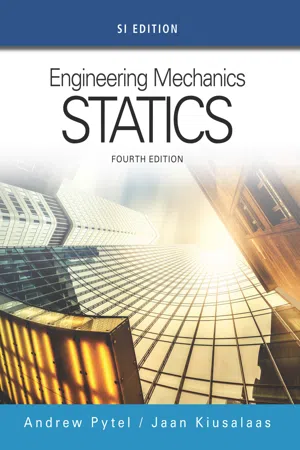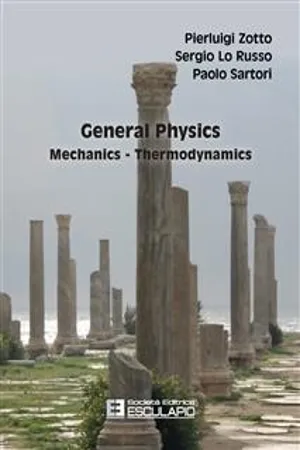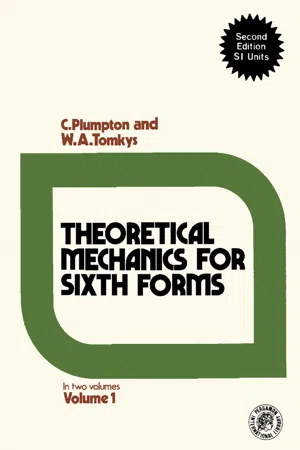Physics
Resultant Force
Resultant force is the single force that can replace multiple forces acting on an object, producing the same effect. It is the vector sum of all the individual forces, taking into account their magnitudes and directions. In essence, it represents the overall effect of all the forces acting on an object.
Written by Perlego with AI-assistance
Related key terms
1 of 5
5 Key excerpts on "Resultant Force"
- Christof M. Aegerter(Author)
- 2018(Publication Date)
- Cambridge University Press(Publisher)
We see, for example, that a force is necessary to move something that was previously at rest. We must also exert a force in order to deform, for example, a rubber band. In all of this, the movement or the deformation is in the direction of the force, therefore a force has the properties of a vector – it not only has a magnitude, but also a direction. The direction of the force is the direction into which the movement or the deformation takes place. When we apply several forces, we see that the effect of all of these forces together behaves as their vector sum as long as they act on the same point. Thus, for two forces acting on the same point of attack, we obtain a Resultant Force: F = F 1 + F 2 . 217 218 Forces and Newton’s Laws of Motion F 1 F 2 F 1 F 2 Figure 6.1 Forces must act on the same point or in the same line of action. We can then treat the problem as if only the resulting force F is at work. If, therefore, two forces act that have the same magnitude but are opposed, then this vector sum gives the following: F = F 1 + F 2 = 0. The two forces cancel each other and nothing happens. The situation is the same as if no force were acting at all. This can be seen, for instance, in a tug of war, where both teams are pulling strongly but hardly anything actually moves. This statement is not at all trivial, and it is important here to note that the forces have to act on the same point, or in the same line of action, as shown in the top sketch in Figure 6.1. Only then is their resulting effect indeed zero and the sum of the forces is a useful quantity to consider. However, if F 1 and F 2 have different lines of action, as in the lower sketch in Figure 6.1, there is a resulting effect: the body starts to rotate. The sum of the forces may be zero, F = 0, but to describe the rotation we would need to consider something called a torque, which takes the line of action into account.- eBook - PDF
Engineering Mechanics
Statics, SI Edition
- Andrew Pytel, Jaan Kiusalaas(Authors)
- 2016(Publication Date)
- Cengage Learning EMEA(Publisher)
101 Strong winds result in significant loads on high-rise buildings. If the pressure distribution is known, the Resultant Force of the wind and the location of the corresponding pressure center can be computed using the principles of statics. Visions of America/Joe Sohm/Digital Vision/Getty Images . Songquan Deng/Shutterstock.com 3 Resultants of Force Systems 3.1 Introduction In order to investigate the effects of a system of forces on a body, it is often convenient to reduce the force system to its simplest equivalent representation. Some of these simplifications have been discussed in the preceding chapter. For example, you have learned that a system of concurrent forces can be replaced by a single force and that a system of couples can be replaced by a single couple. The next article explains how an arbitrary force system can be reduced to a force and a couple. Subsequent articles discuss applications of the force-couple system to the determination of the resultants of force systems. Copyright 2017 Cengage Learning. All Rights Reserved. May not be copied, scanned, or duplicated, in whole or in part. Due to electronic rights, some third party content may be suppressed from the eBook and/or eChapter(s). Editorial review has deemed that any suppressed content does not materially affect the overall learning experience. Cengage Learning reserves the right to remove additional content at any time if subsequent rights restrictions require it. 102 CH A P T E R 3 : Resul tant s of F orce S ys tems 3.2 Reduction of a Force System to a Force and a Couple Here we show how a system of forces can be reduced to an equivalent system con-sisting of a force acting at an arbitrary point, plus a couple. Consider the force system shown in Fig. 3.1(a), consisting of the forces 1 F , 2 F , 3 F , . . . . The position vectors r 1 , 2 r , 3 r , . . . of the points where the forces act are mea-sured from an arbitrarily chosen base point O . - eBook - PDF
- Pierluigi Zotto, Sergio Lo Russo, Paolo Sartori(Authors)
- 2022(Publication Date)
- Società Editrice Esculapio(Publisher)
Dynamics of Systems of Particles 7.1 Introduction Any real body is constituted by a group of molecules, interacting among them or with an external environment, each one assimilable to a point-like particle. The description of the motion of a wide body therefore consists in the description of the motion of a system of N interacting point-like particles. Each element of the system is subject to internal forces F I ( ) due to the action of the other particles of the system and to external forces F E ( ) due to its interaction with the external environment. These forces and their associated torques determine the motion of every particle of the system and therefore the motion of the system itself. 7.2 Resultant Force In a system composed by N point-like particles, the resultant F i of the forces acting on the i-th particle of the system is the vector sum of the internal and the external forces acting on it F i = F i I ( ) + F i E ( ) , where the resultant of the internal forces is due to the action of the other N-1 particles of the sys- tem. Thus, called F ij the force exerted by the j-th particle on the i-th particle we have F i I ( ) = F ij j ≠ i ∑ . The force acting on the system of particles is the resultant of all the forces acting on any ele- ment of the system, i.e. F = F i i ∑ = F i I ( ) i ∑ + F i E ( ) i ∑ = F ij j ≠ i ∑ i ∑ + F i E ( ) i ∑ Called F i I ( ) the resultant of all the forces internal to the system, we find F I ( ) = F ij j ≠ i ∑ i ∑ = 0, because this term is the sum of pairs of forces which are, due to the action and reaction principle, equal and opposite. Newton’s third law in fact states that if the j-th particle exerts the force F ij on the i-th particle, the latter exerts the force F ji = − F ij , on the j-th particle, F 12 m 2 m 4 m 1 m 3 F 13 F 14 F 32 F 31 F 34 F 24 F 23 F 21 F 42 F 41 F 43 141 7 - eBook - PDF
Statics and Mechanics of Materials
An Integrated Approach
- William F. Riley, Leroy D. Sturges, Don H. Morris(Authors)
- 2017(Publication Date)
- Wiley(Publisher)
22 in. 9 in. Figure P2-55 2-56* Determine the magnitude R of the resultant of the three forces shown in Fig. P2-56. Also determine the angles x , y , and z between the line of action of the resultant and the positive coordinate axes. x y z 40° 35° 26° 42° 60° 50° F 2 = 16 kN F 1 = 10 kN F 3 = 24 kN Figure P2-56 2-57 Three forces are applied at the corner of the box shown in Fig. P2-57. Determine the magnitude R of the resultant and the angles x , y , and z between the line of action of the resultant and the positive coordinate axes. x y z F 2 = 20 kip 15 in. 8 in. 8 in. 15 in. 5 in. F 1 = 10 kip F 3 = 25 kip Figure P2-57 2-58 The pin A shown in Fig. P2-58 supports a load F of magnitude 1250 N, and is held in place by a wire AD and compression members AB and AC. If the magni- tudes of the forces C B and C C in the compression mem- bers are 995 N and 700 N, respectively, and the resul- tant of the four forces is zero, determine the magnitude of the force T D . D C F C B C C T D y x 2 m 3 m z 2 m 6 m A B 5 m Figure P2-58 2-7 SUMMARY A force is defined as the action of one physical body upon another. Since the in- teraction can occur when the bodies are in contact or when the bodies are phys- ically separated, forces are classified as either surface forces (a push or a pull produced by mechanical means) or body forces (the gravitational pull of the earth). The characteristics of a force are its magnitude, its direction (line of ac- tion and sense), and its point of application. Since both a magnitude and a di- rection are needed to characterize a force and forces add according to the paral- lelogram law of addition, forces are vector quantities. A number of forces treated as a group constitute a force system. The components of a force are any system of forces that can be combined by the parallelogram law to produce the original force. - eBook - PDF
Theoretical Mechanics for Sixth Forms
In Two Volumes
- C. Plumpton, W. A. Tomkys(Authors)
- 2016(Publication Date)
- Pergamon(Publisher)
The resultant is parallel to the forces of the system. Let it be a force of R in a like direction to the force of 5P and let it act through X in AB distance b from A. The resultant is equal to the vector sum of the forces of the system. .*. R = 6P. The moment of the resultant about A is equal to the sum of the moments of the system about A. .*. Rb = 3Ρχα+5Ρχ2α-Ρχ4α. .. 6Pb = 9Pa. .*. b = 3Λ/2. The resultant is a force of 6P acting in a parallel (like) direction to the force of 5P acting through a point in AB distant 3a/2 from A. 1 p n A a L • Ί 2a p H B 2P 5P FIG. 6.9 Let a force of magnitude Q acting through a point in AB distant c from A be the force which reduces the system to a couple of moment G counterclockwise. The vector sum of the forces of a system which reduces to a couple is zero, .'. Q = 6P and the direction of the force Q is parallel (like) to the direction of both the forces P. The moment of the couple about every point in the plane is G counterclockwise. Therefore the sum of the moments of the system about A is G counterclockwise. .'. 6Ρχο+Ρχ4α-3Ρχα-5Ρχ2α = G. .·. c = (G+9Pa)/6P. Example 2. ABCD is a parallelogram. Prove that forces completely represented by the lines AB, CD, AC, DB have a resultant 2AB in magnitude and position. THE MOMENT OF A FORCE 145 B M C A D FIG. 6.10 AC and BD intersect at O and M is the mid-point of BC (Fig. 6.10). (ÄC+DB) at O = 2(DO+ÖC) at O = 2DC at O. (CD at D) + (2DC at θ) = DC at the point which divides CM externally in the ratio 2 :1 = DC at B. (ÄB at B) + (DC at B) = 2 ÄB at B. Therefore the resultant of the system is represented by 2AB in magnitude, direction and position. Example 3. Forces of magnitude 12 N, 8 N, 5 N act along the sides AB, BC, CA respectively of an equilateral triangle ABC of side 2 m in directions indicated by the order of the letters. A force of P newton acts along BM the perpendicular from B to AC and a force of ß newton acts through B in a direction parallel to AC.
Index pages curate the most relevant extracts from our library of academic textbooks. They’ve been created using an in-house natural language model (NLM), each adding context and meaning to key research topics.




